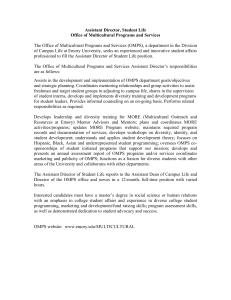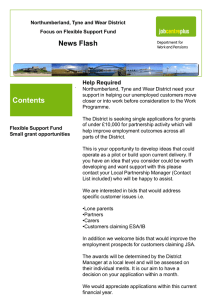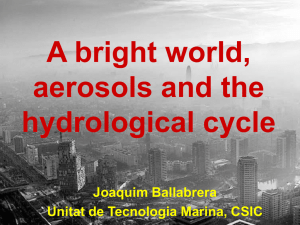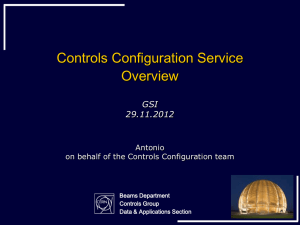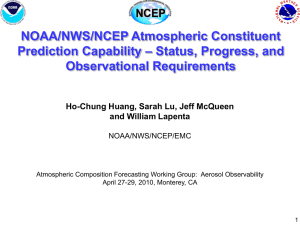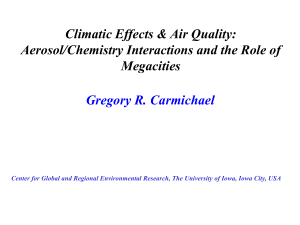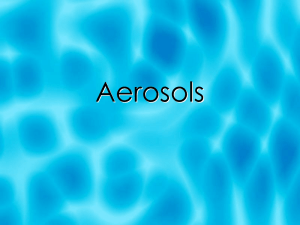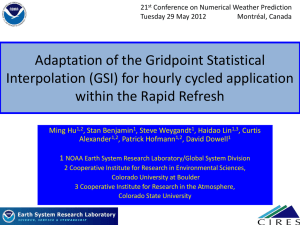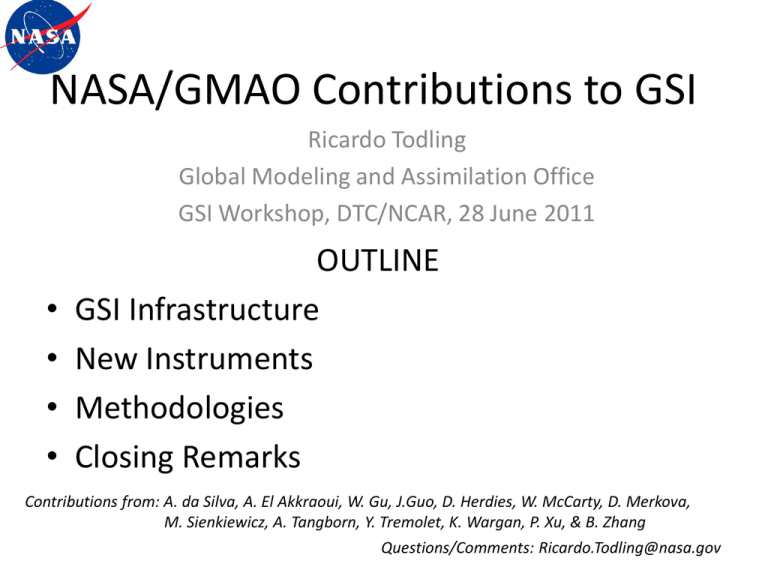
NASA/GMAO Contributions to GSI
Ricardo Todling
Global Modeling and Assimilation Office
GSI Workshop, DTC/NCAR, 28 June 2011
•
•
•
•
OUTLINE
GSI Infrastructure
New Instruments
Methodologies
Closing Remarks
Contributions from: A. da Silva, A. El Akkraoui, W. Gu, J.Guo, D. Herdies, W. McCarty, D. Merkova,
M. Sienkiewicz, A. Tangborn, Y. Tremolet, K. Wargan, P. Xu, & B. Zhang
Questions/Comments: Ricardo.Todling@nasa.gov
Ongoing Development
• GSI Infrastructure:
–
–
–
–
–
Revisit ChemGuess_Bundle
Introduce MetGuess_Bundle
Generalize Jacobian
Introduce interfaces to GSI-Jacobian/CRTM for Aerosols and Clouds
Revisit interface to TLM and ADM for 4D-Var
• New Observation Types and State-Variables:
–
–
–
–
–
MOPITT
SSMI
CrIS and ATMS
OMPS
Doppler Wind Lidar
• Methodologies:
–
–
–
–
Use of cloud-cleared moisture background to assimilate IR instruments
GMAO-GOCART Aerosols influence on radiance assimilation
Add Bi-CG minimization and corresponding Lanczos pre-conditioning
Estimation of tendency-based Q (system error covariance)
GSI Infrastructure
Revisit ChemGuess_Bundle
Introduce MetGuess_Bundle
Generalize Jacobian
Introduce interfaces to GSI-Jacobian/CRTM for
Aerosols and Clouds
Revisit interface to TLM and ADM for 4D-Var
GSI Infrastructure:
ChemGuess and MetGuess Bundles
• GSI_Chem_Bundle renamed to ChemGuess_Bundle
• Introduce MetGuess_Bundle as a means to ingest
meteorological guesses into GSI:
– presently working for clouds-related fields
– being extended to work with basic fields (u, v ,tv, etc)
• anavinfo file:
– Updates made to chem_guess table
– Add met_guess table to control contents for
MetGuess_Bundle
• Future work includes:
– Instantiation of ChemGuess and MetGuess Bundles
GSI Infrastructure
Interfaces to Aerosols & Clouds
• Adding aerosols and clouds
to Guess Bundle allows for
these to be passed to
CRTM; parameter in
anavinfo tables determines
what’s to feed to CRTM and
how.
• Add flexible interface to
allow for user-specific
controls to handle aerosols
and clouds (see Tutorial)
Interface to AD/TL models
• Revisit to support ESMF
• Available interfaces exist
now for at least three global
AD/TL models:
– GEOS-5 FV-dynamics
– GEOS-5 FV-cubed-dynamics
– NCEP Perturbation model
New Instruments
MOPITT Carbon Monoxide
SSMIS
CrIS and ATMS
OMPS O3 (OSSE-like)
Doppler Wind Lidar (OSSE-like)
New Instruments: MOPITT CO
MOPITT - Measurements Of Pollution In The Troposphere
Changes entail:
- mild change to obsmod
- add usual suspects when
handling new observing
types, e.g.:
- readCO
- setupCO
- intCO
- stpCO
- Estimate and set B(co).
(from Andrew Tangborn)
• Four profiles of MOPITT CO are randomly placed on the globe
and assimilated using GSI. Preliminary results are consistent with
shape of averaging kernel.
• Cycling experiments are on the way.
New Instruments: OMPS O3 (OSSE)
OMPS – Ozone Mapping and Profiler Suite
• High Fidelity Measurements:
-Total column (like TOMS)
-Vertical profiles (like SBUV)
• OSSE Setting:
-Generate truth: MLS-O3 & OMI/TC
-Simulate Radiances – Forward RT
-Apply Instrument Models
-Retrieve Profiles
-Assimilate Retrievals (GEOS-5 DAS)
-1 degree resolution
(from Philippe Xu)
Results show:
- Data are ingested into GSI at all levels
- QC control works (but rate of rejection can be adjusted)
- Analysis works effectively
- Penalties are in good range
- Time series show fast convergences
- OMA and OMF are all very small and OMA are smaller than OMF
New Instruments: OMPS O3 (OSSE)
OMPS – Ozone Mapping and Profiler Suite
a) 5 hPa
b) 100 hPa
Analysis error (%) of retrieved ozone assimilation from TRUTH
- At 5 hPa errors are small in most of region; orbit tracks of OMPS analysis
are noticeable.
- At 100 hPa errors are large where retrievals are most difficult: Tropics as
the ozone value are very small (<0.1ppmv).
(from Philippe Xu)
New Instruments: OMPS O3 (OSSE)
OMPS – Ozone Mapping and Profiler Suite
Retrieved vs MLS TRUTH (%)
OMPS sampled vs MLS TRUTH (%)
Monthly Zonal Mean analysis errors
• The results show that OMPS data agree well with MLS in the
stratosphere and in most of the troposphere.
• In the tropical UT and LS there is large discrepancy (%) between MLS and
OMPS, where the ozone mixing ratio are very small (<0.1 ppmv); needs
more work.
(from Philippe Xu)
New Instruments: Doppler Wind Lidar (OSSE)
• Measurements ESA/Aeolus:
-Rayleigh backscatter (clear sky)
-Mie backscatter (clouds/aerosols)
• OSSE Setting:
-ECMWF Nature Run (NR)
-Errico’s simulated observations
-Simulated obs:
-KNMI Lidar Perf Anal Simul
(LIPAS)
-LOS: GEOS-5 replay with
GOCART forced with NR
-Experiments assimilate
-DWL (Rayleigh and Mie)
-Rayleigh only
-Mie only
-1/2 degree resolution
(from Will McCarty)
Results show:
-Diminished impact toward surface
- less observations
- large contamination
- Nearly neutral in NH/SH
- winds larger determined by balance
New Instruments: Doppler Wind Lidar (OSSE)
Changes entail:
-mild change to
obsmod
-And typical
- read_lidar
- setupdw
- intdw
- stpdw
Reduction in RMS
by adding DWL
(from Will McCarty)
Increase in RMS
by adding DWL
New Instruments: Doppler Wind Lidar (OSSE)
Results indicate:
- Upper-troposphere
- Mie impact neutral away from tropics; mildly positive in tropics
- Rayleigh impact positive throughout; dominates in tropics
- Lower-troposphere
- Mie and Rayleigh give redundant impact: either provides all information
- All-in-all OSSE tends to over-state impact of observing system
- Obs error need to be better adjusted (esp. for Mie)
(from Will McCarty)
Methodologies
Use of cloud-cleared moisture background to
assimilate IR instruments
GOCART Aerosols influence on radiance
Bi-CG minimization and Lanczos pre-conditioning
Estimation of tendency-based Q (model error)
Methodologies: Cloud-cleared q variable for IR
Changes entail:
- add cloud frac to guess
- cloud frac to crtm_interface
(water-vapor)
Picture displays mean OmF for AIRS calculated using full q variable (red)
and cloud-clear q variable; some reduction in bias is observed when new
is used – results are still preliminary.
(from Dagmar Merkova & A da Silva)
Methodologies: Aerosol Radiance
Contamination
•
•
CRTM allows for the inclusion of (GOCART)
aerosols
The GEOS-5 GOCART aerosol species have been
introduced as state variables in GSI
AOD Validation
MISR
– No aerosol analysis for now
– Aerosol effects included in the observation operators
for IR instruments: AIRS, HIRS, IASI, etc
• Control Experiment:
–
–
–
–
Fully interactive GEOS-5 GOCART aerosols
Standard global GSI
ARCTAS period: Summer 2008
Resolution: ½ degree
GEOS-5
• Aerosol Experiment:
– Fully interactive GEOS-5 GOCART aerosols
– GSI observation operators:
• 15 GOCART species
– Concentrations
– Effective radius
• CRTM internal optical parameters
(from A da Silva and Dirceu Herdies)
GEOS-5 overestimates dust
Methodologies: Aerosol Radiance
Contamination
Dust Distribution for July 2008 event off West Coast of Africa
(from A da Silva and Dirceu Herdies)
Methodologies: Aerosol Radiance
Contamination
Temperature Analysis: DT = Taero - Tcontrol
(from A da Silva and Dirceu Herdies)
Methodologies: Aerosol Radiance
Contamination
Observation Count
Residual Statistics
Control
Aero effects
About 3% more AIRS
observations are accepted
(from A da Silva and Dirceu Herdies)
Neutral impact to residual error statistics
Methodologies: Lanczos Bi-Conjugate Gradient
Objective: aid general formulation of WC-4dVar
BiCG
Double CG
BiCG w/ ortho
Double CG w/ ortho
CG w/ ortho
Lanczos CG
Lanczos BiCG
Remarks:
- CG solves symmetric case
- Double CG solves non-symmetric case
- Double CG uses B-precond
- Lanczos CG uses sqrt(B)-precond
- BiCG solves non-symmetric case
- Lanczos BiCG uses B-precond
Changes entail:
- add Bi-CG driver
- mild glbsoi update
- mild gsimod update
- mild gsi_4dvar update
Results highlight two aspects of CG:
-Orthogonalization of gradients considerably improves convergence
-Lanczos BiCG same as Lanczos CG, but
former applies for non-symmetric case
(from Amal El Akkraoui)
Methodologies: Estimation of Q (model error)
Q-st
B-st
Q-vp
B-vp
Q-t
B-t
Figure above shows normalized impact of
observations within analysis window for
SC and no-B WC.
Plots show horizontal scales for B and prototype Q for stream function, velocity
potential, and temperature at 45N obtained over a four-month sample of
forecast full fields and tendencies, respectively.
(from Banglin Zhang & Wei Gu)
Closing Remarks
• Completing comparison of SC and WC-4dVar
in prototype GEOS-5 4dVar system.
• Making progress in bringing GEOS-5 CubedSphere TLM and ADM to maturity.
• Started working on hybrid ensemble
components for GEOS-5 3d- and 4d-Var.
Collaboration with NCEP is ongoing and fundamental
for the success of these implementation.
New Instruments: OMPS O3 (OSSE)
OMPS – Ozone Mapping and Profiler Suite
• Generate TRUTH
• Simulate Radiances
-
-
-
GEOS-5.2.0 (MERRA tag)
1x1.25°L72 resolution
Conventional data & satellite
radiances impact meteorology
Simple chemistry: O3 P&L in GCM
MLS O3 profiles (215-0.1hPa) and
OMI TC assimilated
Hourly analysis output
-
-
Interpolate TRUTH to OMPS/LP
observation points to 1-km profile
RT with pseudo-spherical
atmosphere, multiple scattering,
refraction, tangent shift, etc.
Random surface reflectance, cloudtop height simulated and aerosol
selected from SAGE-II database
Validation
• Assimilate
Retrievals
-
-
OMPS/LP data added
to GSI in GEOS-5.6.1
The o3lev observer is
used, same as for MLS
QC flag for retrievals
• Retrieve Profiles
-
-
Rodgers’ Optimal Estimation
Climatology as a-priori
First retrieve cloud-top
height, tangent height,
surface reflectance and
aerosol distributions
Ozone profile retrievals
• Apply Inst.
Models
- Instrument
Simulator Model
- Deconvolution
Model
- Consolidation Model

